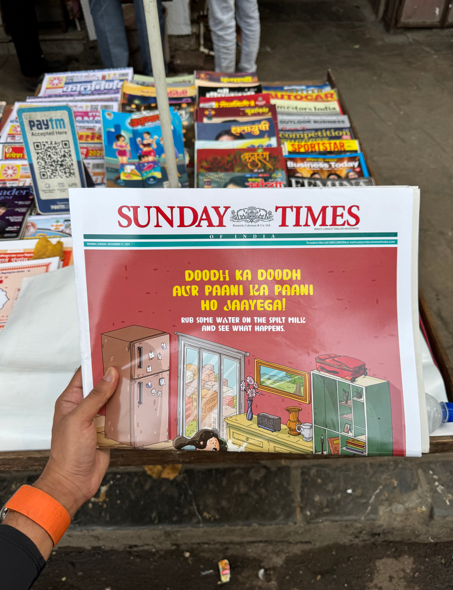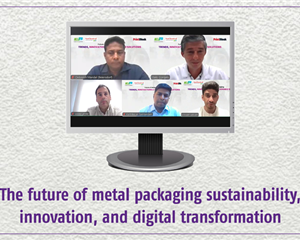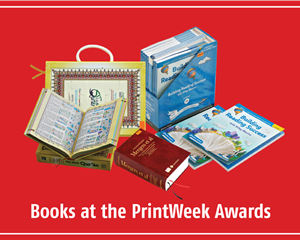Top Job: Dot Printers' Flipkart ad campaign — The Noel D’Cunha Sunday Column
Vasai-based Dot Printers, a creative print subsidiary of Arihant Enterprise and The Times of India (TOI) used hydro-reactive ink technology in a campaign for Flipkart Minutes, showing how print can create interactive and engaging experiences for audiences. In this Sunday Column, we tell you how Deep Shah and his team created this Top Job. Read on…
01 Dec 2024 | By Noel D'Cunha
In a world increasingly captivated by digital advertising, print media is proving it has more to offer than ever before. The Flipkart Minutes campaign, crafted by Vasai-based Dot Printers, a creative print subsidiary of Arihant Enterprise and The Times of India (TOI), showcased how innovation can redefine the potential of traditional media. By leveraging hydro-reactive ink technology, this campaign provided an interactive, multi-sensory experience that left an indelible impression on audiences, positioning print as a powerful storytelling medium.
Dot Printers houses one of the finest screen printing technologies. Dot Printers's infrastructure includes a fully automatic screen printing press from Sakurai, a Japanese masterclass machine with maxed-out features among other equipment. The family-owned organisation, spearheaded by Jayesh Shah, founder and chairman of Dot Printers, has been helping brands to create value addition for the past seven years through screen printing applications. Dot Printers are capable of handling complex curing and reactive inks with projects that need more to life than just simply printing ink on paper.
The Flipkart Minutes campaign was born from a simple yet audacious vision: transform a print ad into an interactive experience that could surprise and delight readers. The concept revolved around using hydro-reactive ink to create a ‘hide-and-reveal’ mechanism, where the advertisement’s hidden message would only appear when water was applied to the page. This choice of medium was no coincidence. For Flipkart’s new Quick-com service, the campaign needed to embody speed, efficiency, and surprise—qualities that hydro-reactive ink could perfectly convey.
“The thought process was to produce an interactive piece of content that would create a curiosity factor among the users through a different printing technique,” explains Deep Shah, director and creative head, Dot Printers and also the key coordinator of the project. The ideation stemmed from a collaborative effort between TOI and Flipkart’s marketing teams, who approached Dot Printers with a challenging brief and a tight timeline.
Delivering such an ambitious vision required both creativity and precision. “TOI were looking for a solution provider who could execute this concept confidently,” Shah shares. “Undertaking time-sensitive projects is not new to us, as we have always built our business around a service-oriented mindset from day one. So we were confident enough to execute it within their prerequisites.”
This spirit of collaboration and Dot Printers’ technical expertise laid the foundation for the campaign’s success.
The technology behind the magic
At the core of the Flipkart Minutes campaign was hydro-reactive ink—a specialty ink that transforms ordinary print into something extraordinary. This ink has a unique property: it becomes transparent when water exposes the hidden message or image beneath. What makes it truly special is its reversibility; once the water evaporates, the ink returns to its original opaque state, repeating the experience multiple times.
“This ink has a very unique property,” Shah explained. “On contact with water, the ink’s opaque nature disappears completely, and the message becomes fully visible. The beauty is that the ink itself is water-resistant, meaning it wouldn’t come off when in contact with water. This kind of technology works best when you want to create a haptic and interactive experience, especially with a ‘hide-and-reveal’ concept.”
Hydro-reactive ink originated in high-security printing, where its transformative properties were used in banknotes and authentication materials. Over time, chemistry and printing techniques advancements have expanded its applications to advertising, novelty products, and packaging. The Flipkart Minutes campaign capitalised on this evolution, using hydro-reactive ink to bridge the gap between functionality and creativity in print advertising.
According to industry reports, the global market for specialty printing inks, including hydro-reactive varieties, is expected to grow by over 6% annually, driven by the increasing demand for customisation and innovation in print campaigns. This growth highlights the immense potential for interactive print solutions to shape the future of advertising.
Overcoming challenges
While the concept was groundbreaking, the road to execution was fraught with challenges. Hydro-reactive ink posed several technical hurdles, from substrate compatibility to curing requirements. The ink required extremely high drying temperatures—over 120°C—to ensure the water content was fully evaporated without compromising the ink’s reactive properties.
“The biggest challenge was to develop the right ink as per the substrate demands,” Shah informs. “During the trial phase, we knew that drying this ink with a target production speed in mind would be the biggest challenge.”
Dot Printers undertook significant modifications to their production facilities to meet these demands. “We amplified our drying capacity by adding additional drying lamps and a completely new heater lamp system to achieve the output within the given timeline,” Shah explains. Multiple trial runs were conducted to understand how the ink behaved under different speeds and temperatures, ensuring a flawless final product.
Beyond the technical aspects, logistics added another layer of complexity. The campaign required producing and distributing the interactive ads across multiple cities within a tight deadline, demanding impeccable coordination and efficiency.

The future of interactive print advertising
The Flipkart Minutes campaign offers a glimpse into the future of print advertising, where innovation and interactivity take centre stage. This project was more than a technical challenge for Dot Printers—it was a reaffirmation of their value creation philosophy.
“Everybody is printing ink on paper,” Shah observes. “What matters most is what you do differently. Creating new print experiences has been pivotal for our brand-building journey.”
Shah believes that the scope for interactive print is enormous, particularly as brands look for ways to engage audiences in an increasingly saturated digital landscape. “This print ad would create a strong interest in many brands using different sensory experiences,” he says.
Dot Printers has already begun exploring other multi-sensory printing techniques, from tactile finishes to scented inks, positioning itself at the forefront of experiential print advertising. “By engaging multiple senses, these innovations offer brands a deeper connection with their audiences, creating moments that resonate long after the initial interaction,” explains Shah.
Hydro-reactive ink, in particular, has untapped potential in various industries, from luxury packaging to educational materials. “Its ability to surprise and engage makes it a powerful tool for storytelling, whether for brands seeking differentiation or educators aiming to inspire curiosity,” says Shah.
Print that goes viral
When the campaign launched in TOI’s Sunday edition, it immediately captured the audience’s imagination. The ad’s bold design—hiding Flipkart’s branding until the reader engaged with it—invited curiosity and participation. This novel approach exemplified how print could transcend its traditional limitations to create an engaging and memorable experience.
“The brand took a very bold move by not revealing its name on the newspaper's front page,” Shah says. “This form of interaction has created an everlasting impact on the customer’s mind. In fact, audience reactions have gone viral online, with people talking about how print ads can be more than just one form of visual communication.”
The campaign’s success was amplified by its resonance on social media, where readers shared videos and photos of the ad in action. This virality underscored the power of interactive print to generate excitement and extend its reach beyond the physical page.
While concrete metrics on brand recognition and engagement are still emerging, the Flipkart Minutes campaign has already proven its worth as a creative milestone in print advertising.
Print’s role in value creation
The Flipkart Minutes campaign is not just a success story for Dot Printers—it’s a call to action for the entire print industry. It demonstrates that with the right blend of technology and creativity, print can do what digital often cannot: create tangible, memorable experiences that leave a lasting impression.
As Shah puts it, “Print is a multi-sensory form of communication today. It’s not about competing with digital; it’s about doing what print does best—creating unforgettable experiences.” He adds, “Ever since I joined the print industry, we never really want to do the same thing every week. Creating new print experiences has been pivotal for our brand-building journey. We are never really interested in a project that doesn't demand something new or different from our side, and that ideology always pushes me to push for newer processes and avenues. Today, we are proud to say we can touch upon three different senses of communication - see, touch, and smell with our printing techniques.
However, Shah says the biggest takeaway for his team from executing this project was that working with big brands reminds us what a ‘commitment to excellence’ is. “I believe brands like Times of India are truly the best in the game because they always believe in strong delivery commitments. Our biggest challenge in this project was fighting against time. Every minute was critical as we also had to produce these posters for multiple city locations.”
With hydro-reactive ink and other interactive technologies leading the way, the future of print is bright, vibrant, and full of possibilities. “Far from being obsolete, print is evolving into a medium that combines the best of tradition and innovation, proving that it’s not just alive—it’s thriving,” concludes Shah.












 See All
See All